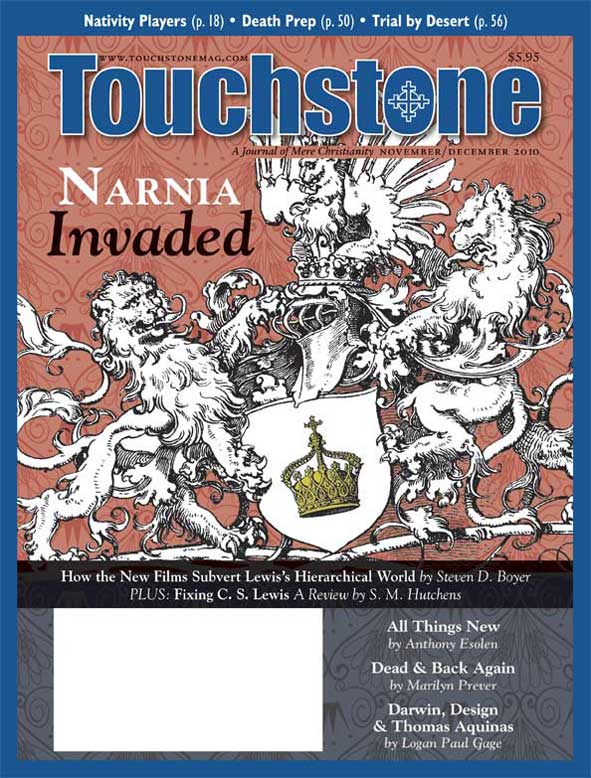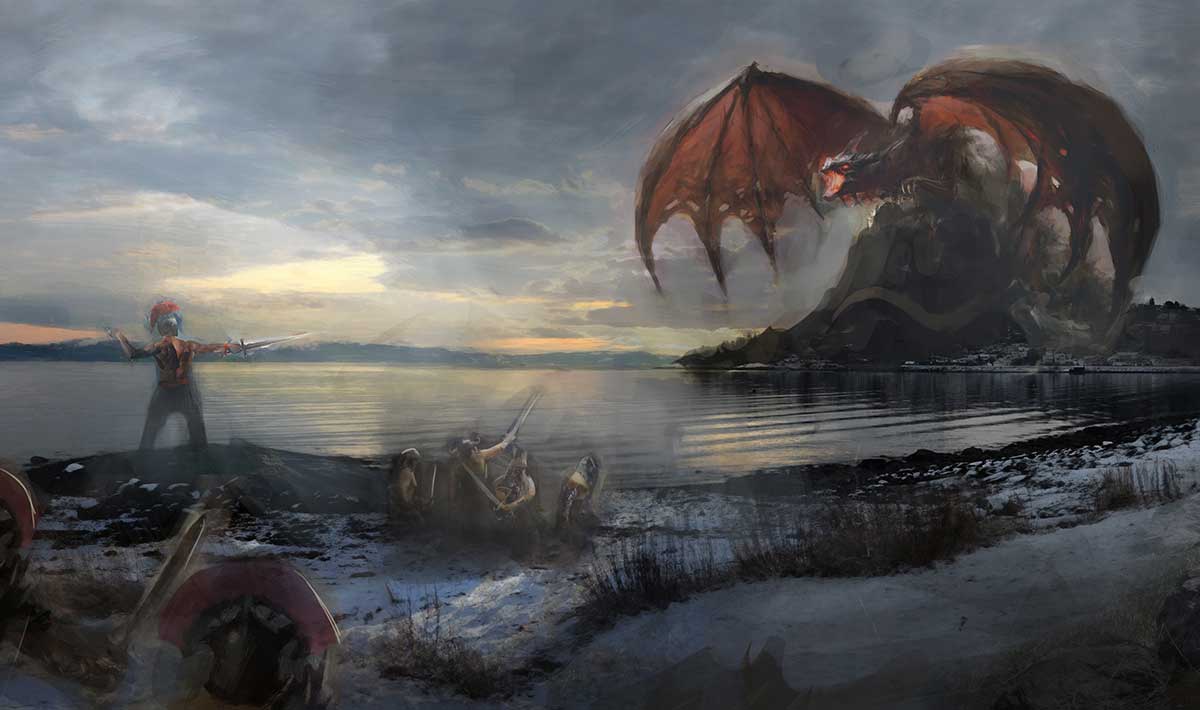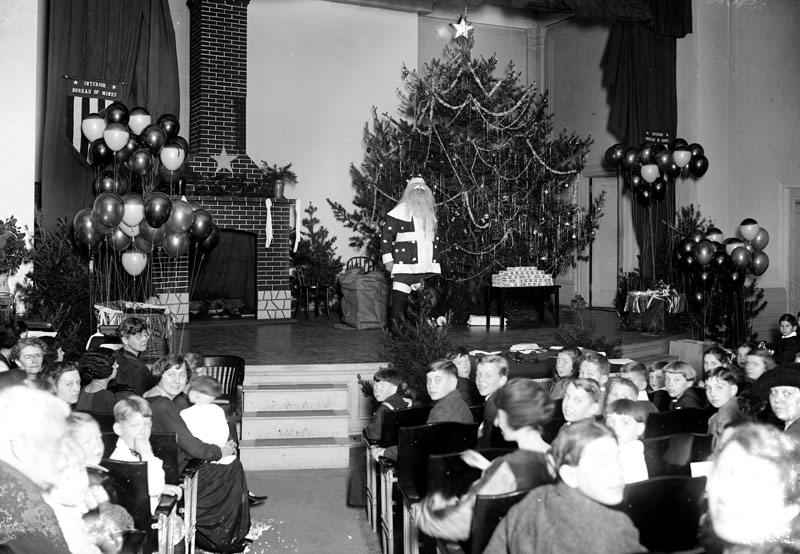Narnia Invaded
How the New Films Subvert Lewis’s Hierarchical World
by Steven D. Boyer
As everyone knows, two Hollywood productions of recent years bear the titles of two of C. S. Lewis’s famous stories from The Chronicles of Narnia: The Lion, the Witch and the Wardrobe and Prince Caspian. The third installment in the series, The Voyage of the Dawn Treader, is scheduled for release this December, with The Silver Chair slated for 2011.
Many Christians are very excited about these developments, believing (quite rightly) that Lewis’s stories are shot through with deeply Christian imaginative themes. What can be wrong with disseminating the stories more widely in this way? The answer is: Absolutely nothing—so long as it really is Lewis’s stories being disseminated. But there’s the rub. A thoughtful investigation suggests that the Narnia films are very far from being a faithful representation of Lewis’s own Christian vision of reality.
This is a serious charge, so let me focus it a bit more. I shall not object to the quality of the movies simply as movies, nor to the interpolation of much non-Lewis material into both movies, nor even to the appropriateness of film, in principle, as a vehicle for telling such stories. Objections might be made (and have been made) on all three points, but I shall not make them here.
Instead, I have a larger and more basic question in mind. Do these film versions “do” what Lewis’s books themselves “do”? Do those who see the films come away nourished in the same way that readers of the stories do? Do the films give us, or do they try to give us, something recognizably like Lewis’s comprehensively Christian vision of the world?
A Peculiar Love of Hierarchy
In order to address questions like these, we have to ask first what Lewis is trying to do. What is his “Christian vision of the world”? We could address this question by focusing on the Narnia tales specifically, but it ends up being more productive (and avoiding some of the twists and turns of scholarship on Narnia) to begin with a broader account of Lewis’s basic theological outlook, and so that is what we shall do.
Understanding this basic outlook does bring with it, however, one really substantial obstacle: we have to think carefully about a significant element in Lewis’s vision that does not play very well in our world, even among contemporary Christians. That element is Lewis’s peculiar fondness for hierarchy.
The word “hierarchy” does not have very pleasant connotations in our day, so to speak of someone being “fond of hierarchy” sounds very “peculiar” indeed. It is like admitting that your great-uncle Jack, really a fine old gentleman, never got over his childhood delight in pulling the wings off flies. Of course, this odd and even repulsive idiosyncrasy might be ignored by members of the family, out of their affection for Uncle Jack.
The only problem with treating Lewis this way is that his particular oddity reappears everywhere in his work, usually quite explicitly, and it has an exceptionally strong bearing upon the way he understands orthodox Christianity. If we are going to understand Lewis’s deeply Christian vision of the world, we will need to try hard to understand how this suspicious attraction to hierarchy is a part of it.
Two Interlocked Principles
Lewis’s thinking begins with the Christian understanding of God as the Creator of the world, and of the world as God’s creation. The historic Christian doctrine of Creation requires Christians to insist on uniting two fundamental principles, and oddly enough, two principles that the contemporary outlook is often prone to separate.
First, it insists upon hierarchy. We might not use this term very often, but it is clear that any serious doctrine of creatio ex nihilo (“creation out of nothing”) involves the recognition of a very real hierarchical distinction between God and world. The difference between the great Creator who gives reality and the cosmos that receives reality is absolute. The one is utterly independent, the other utterly dependent. The one is worthy of all worship; the other rightly offers this worship. There is here a hierarchy of the deepest, richest kind, for in every imaginable respect, the world is subordinate—and rightly subordinate—to the God who creates and constantly sustains her.
Yet right alongside this affirmation of hierarchy in the Christian doctrine of Creation, we find the insistence that creation is fundamentally, unambiguously good—and with a goodness that grows directly out of its unqualified dependence upon its Creator. Note the surprising interpenetration of these two principles. Creation is not good in spite of its subordination to God, in spite of the hierarchy; it is good because of its subordination, because of the hierarchy. It is good because it is created, and to be created is to be glorious precisely by virtue of reflecting or showing forth the greater, higher glory of the Creator.
Indeed, as soon as any created thing ceases to be rightly subordinate to God, that creature ceases also to be good. It becomes a competitor with God, like Molech or Baal or Satan, rather than a servant of God. This is the essence of sin in Lewis’s mind: it is a turning away from our true creaturely status. It is an attempt to replace the goodness that naturally comes from being subordinate to God the Creator with a different, independent, autonomous goodness. It is a rejection of God.
Delight in Hierarchy
So hierarchy, by its nature, is fundamentally good. And Lewis follows the overwhelming majority of the Christian tradition by going further, by believing that the goodness of hierarchically ordered relationships extends all through the world that God has made. Relationships of all kinds are ordered, Lewis thinks, with an appropriate kind of giving and an appropriate kind of receiving. When that order is respected, real joy and freedom are the result.
Now we don’t have space here to pursue this idea very far, but the point is absolutely crucial: in Lewis’s mind, hierarchy is the source of freedom. This means that, as odd as it sounds to most of us, hierarchical order is something that we all ought not to hate or to fear, but to delight in.
To be sure, hierarchy has been abused, and Lewis is well aware that, in a fallen world, we need equality as a protection against that abuse. But it is one thing to protect ourselves from the abuse of hierarchy, and it is another to reject outright the thing that is abused—and it is this latter error that the modern world has fallen into. Finding that hierarchy has been abused, we have rejected hierarchy in principle.
But this is a dreadful mistake. It is like discovering that some of our food has been poisoned and therefore resolving never to eat again. Worse still, if Lewis is right, this rejection of hierarchy is nothing less than a rejection of a fully Christian way of seeing the world.
Countercultural Creativity
Of course, it is another question whether Lewis really is right about all of this. It seems to be a pretty important question. Unfortunately, it is also a question that most of us have very few resources to answer honestly, for the simple reason that, for most of us, “good hierarchy” is a contradiction in terms. The very word hierarchy usually has a ring of doom to it in our culture: it reeks of domination and oppression. For most of us, even to consider the possibility that something called hierarchy could be a good, edifying thing will take an intentional, countercultural act of creative imagination.
Enter The Chronicles of Narnia. At last, we are in a position to see at least part of what Lewis is up to in these delightful tales. He wants to remind us what a beautiful, elegant, adventurous, festive place the world can be, and he thinks that right order is a part of that good world. Through these stories, Lewis gives us the imaginative tools to think critically—he would say to think more Christianly—about our own cultural assumptions regarding hierarchy, equality, and so on.
We can see Lewis’s strategy at work if we just think for a moment about what his original stories are like. Narnia is a great repository of hierarchical images and relations—of good kings and noble knights, of laborers who are not disgruntled and servants who are not demeaned, of Aslan the great Lion who rules over all, who is never safe, but always good.
One can hardly turn a page of The Lion, the Witch and the Wardrobe or of Prince Caspian without encountering compelling images of royal authority and knightly virtue—and we see now that both of these themes are intimately connected with Lewis’s positive construal of hierarchy, which in turn is foundational to his distinctively Christian vision of reality.
Hollywood Shifts the Center
So, what about Hollywood? Is the Christian vision of the Narnia films anything like that of Lewis’s own Narnia stories? That is the question we turn to next.
Let us begin with some brief attention to Walden Media’s 2005 production of The Lion, the Witch and the Wardrobe—very brief attention, since we need to spend more time on Prince Caspian. This brevity is unfortunate in a way, because I think there really is a fundamental shift in focus in this first film, a shift from a story that is chiefly about Aslan to a story that is chiefly about the children, and especially about Peter as he grows toward maturity. To be sure, Aslan is quite helpful along the way, but he is no longer the center—and that is big news, if we are thinking about Lewis’s Christian worldview. So there is much more to be said about this first film, even if we do not have time to say it here.
Yet we must take time to note one aspect of Peter’s growing up that turns out to be especially relevant to our concerns. The greater part of Peter’s maturation is his learning to take responsibility for his situation rather than just quietly acquiescing in it. He must learn to take risks even in the teeth of Susan’s ever-so-rational good sense; he must learn to follow his own judgment, not just do what “Mum” would want him to do. This is not a bad lesson: unquestionably, maturity does involve this kind of growth toward independence. But consider the way this growth is formulated in the film.
The opening scene shows us an air raid in London, and we find Peter very angry at Edmund because the younger boy, rather than running to the bomb shelter as he has been instructed to do, runs back into the house to retrieve a photograph of his father and then has to be rescued by Peter. Peter performs the rescue all right, but he also savagely chastises his brother: “Why can’t you just do as you’re told!?”
A Strange Sign of Maturity
These are very significant words, for the movie as a whole consists in Peter learning to think and act independently—learning, in fact, not to do as he is told. The value of this kind of “disobedience” reappears frequently, but most significantly near the end of the film, in the high, climactic moment when the great battle against the White Witch seems all but lost. In despair, Peter commands Edmund to “get the girls and go home”—that is, to abandon this losing fight and get their sisters to safety. But the reformed Edmund now shows his own new maturity and virtue, and he shows it by disobeying.
It is a good move: by staying in the battle, Edmund is able to break the Witch’s wand and thus to contribute in no small way to the Narnian victory. In the celebration immediately after the Witch’s death, with everything now won and Edmund proved a hero, Peter offers a teasing, tongue-in-cheek “rebuke” to Edmund that takes us right back to the opening of the movie: “When are you going to learn to do as you’re told?” he hollers. Of course, he doesn’t mean it anymore. By now, he has grown enough to realize that receiving orders and following them is a sign of immaturity and weakness, whereas independent action, especially when it involves not doing as you’re told, is the sign of strength, maturity, and success.
Note well: disobedience is the sign of real maturity. This quiet, unobtrusive devaluation of humble submission to rightful authority is a significant omen of things to come in the later film.
Which brings us to the 2008 production called Prince Caspian. This film once again makes Aslan peripheral, and it also includes a greater number of departures from Lewis’s original story, including a sixteen-minute siege on the castle of the usurper Miraz that is nowhere in Lewis’s text. This film also addresses much more frequently and explicitly the important theme of hierarchy. Yet it is a hierarchy much different from that of Lewis’s books, and different in some pretty far-reaching ways.
This difference is evident absolutely everywhere in the film. One could look at Caspian himself, who is transformed from a noble and honorable young king in Lewis’s telling, into a tortured warrior whose unchecked desire for personal revenge against his father’s murderer leads to the deaths of scores of his Narnian subjects. Or again, one could look at the virtuous Red Dwarf Trumpkin, whose cheerful, good-humored embrace of obedience in Lewis’s story is quietly dropped from the film, replaced by the more modern virtues of sarcasm, irony, and cynicism.
Peter the Problem
But let us pass over examples like these and focus instead on that one character who demonstrates most clearly in the film that Lewis’s positive vision of hierarchy is not merely being overlooked by his Hollywood interpreters but is being self-consciously attacked. That character is the High King Peter.
The Peter we meet in the film version of Prince Caspian is a very different Peter from the one we saw grow up in the earlier film and certainly very different from the one in Lewis’s story. In the first place, it is hard to describe Hollywood’s Peter as anything other than a bumbler. He is not part of the deliverance that comes from the blowing of Queen Susan’s magic horn. He is instead part of the problem, a stupid, proud, boorish, arrogant fool who speaks and acts with ridiculous vanity and, far from delivering others, needs to be delivered himself. His arrogance and vanity are explicitly highlighted in the film:
• We first encounter Peter as the cause of a brawl in a London subway, which he started simply because someone bumped him.
• Once in Narnia, Peter sets out to lead the other children and gets hopelessly lost, but he keeps insisting (with stereotypical male vanity), “I’m not lost,” “We weren’t lost,” etc.
• When he finally assumes command of the Narnians and then is confronted by Lucy, who tries to talk sense into him and get him to wait patiently for Aslan, he condescendingly replies, “I think it’s up to us now. . . . We’ve waited for Aslan long enough.”
• In the enemy castle, in the midst of their failed attack, Peter stupidly and obstinately refuses to call for retreat, crying out instead, “No, I can still do this!”—which prompts Susan to ask, “Exactly who are you doing this for, Peter?”
These instances could easily be multiplied. At every point, the Peter of Hollywood’s Prince Caspian is the problem, not the solution. The high king of Narnia seems to have devolved into a young, handsome version of Homer Simpson.
Adamson’s Aim
But how has this happened? The point here is absolutely decisive. The makers of the film leave us in no doubt whatsoever that the brashness and insolence and haughtiness of Peter in the second film are precisely the result of his having been exalted as king in the first one.
Our first encounter with Peter in Prince Caspian makes this point quite intentionally. The scene opens with a general mêlée in the subway station, of which Peter is the cause. Order is finally restored by the intervention of the police, and then the four children are left waiting for a train. Susan takes this opportunity to ask Peter caustically, “What was it this time?”—giving us an unmistakable hint that this clash was only the latest in a series of conflicts that have had Peter at their center. After Peter explains what happened (including the satisfied acknowledgment that he himself threw the first punch), Susan sighs and asks, “Is it that hard just to walk away?” Peter snaps back, “I shouldn’t have to!”
Then follow some remarkable lines. Says Peter, “Don’t you ever get tired of being treated like a kid?” “We are kids,” Edmund wryly observes. “Well, I wasn’t always,” Peter retorts. He is obviously remembering that he used to be a king in Narnia—and he wants the kingship back.
Director Andrew Adamson helps us understand just what is going on in this scene in a commentary that is one of the bonus features on the Prince Caspian DVD. Adamson explains,
I always felt . . . how hard it must have been, particularly for Peter, to have gone from being high king to going back to high school, and what that would do to him, do to his ego. . . . I always thought that would be a really hard thing for a kid to go through.
Adamson acknowledges that this emotional turmoil was “not something that C. S. Lewis really got into,” but as director he wanted “to create more depth for the characters, more reality to the situation.” He wanted “to deal with what all the kids would go through having left behind that incredible experience and wanting to relive it.”
This emotional realism was Adamson’s explicit aim, and as a result, the screenwriters who put this scene together were actively encouraged to think about what it would be like to go from “king” to “schoolboy”—not a pleasant prospect, of course, and one to which any of us might react with bitterness and resentment, just as Peter does.
Right, any of us might react that way—but that is because we have not breathed the air of Narnia. We are thinking like ordinary persons (and worse, like self-sufficient, twenty-first-century, Western intellectuals) instead of like knights or kings. In Lewis’s telling of all of the Narnia tales, the children’s experiences as kings and queens in Narnia consistently transform them into nobler, more virtuous people in their own world. They are not spoiled children wanting to be kings again; they are noble kings who carry that very nobility back into their non-royal roles as schoolchildren.
But not so in Hollywood. To be a king at all is to hunger for power forevermore, like a tiger that has tasted human blood and ever afterwards is a “man-eater.” To lose imperial power by being transported back to England is to become a bitter, sullen, acrimonious brat. That is just what Peter has become, and his folly is the driving force behind most of the action in the movie.
Two Royal Stinkers
The difference between Lewis and his Hollywood interpreters could hardly be greater on this score, and it is demonstrated most clearly in the astonishingly different ways that the relationship between Peter and Caspian is portrayed in the film and in Lewis’s own text. The film version shows us a relationship of almost unrelieved hostility, suspicion, and animosity. It begins when Peter and Caspian first meet and mistake one another for opponents. They finally realize that they are fighting on the same side, but the civility that is practiced thereafter is obviously a thin veneer that masks a seething competition between them.
The conflict comes to a head after the failed attack on Miraz’s castle. As we have already noted, part of the fault for the failure lies with Caspian for abandoning the original strategy in order to pursue his own plans for vengeance, and part of the fault belongs to Peter for his proud insistence that no retreat be allowed until it is too late. But given what we have already seen of their characters, it is no surprise that each of these royal stinkers refuses to recognize his own part in the fiasco and instead blames the other.
The result is a fierce public quarrel that finally descends into a childish exchange of insults. When Lucy asks what happened in the battle, Peter spitefully replies, “Ask him.” Caspian is shocked to be blamed, and he retorts, “You could have called it off. There was still time.”
Peter: “No, there wasn’t, thanks to you. If you had kept to the plan, those solders might be alive right now.”
Caspian: “And if you had just stayed here like I suggested, they definitely would be!”
Peter: “You called us, remember?”
Caspian: “My first mistake.”
Peter: “No, your first mistake was thinking you could lead these people.”
(One can almost hear the “Nah-na-nah-na-nah-nah!” in the background.) The insults continue and escalate, until Peter even insults Caspian’s father—at which point swords are drawn in rage, and violence is barely averted.
Two Noble Kings
This account of hatred and rivalry and mutual recrimination is about as far as it could be from Lewis’s own account of the relationship between these two noble kings. For Lewis, that relationship is overwhelmingly marked by support, trust, and generosity.
Consider just a few lines from the drastically different story that Lewis tells of the first meeting of the kings. In Lewis’s story, that meeting takes place just after Peter has leaped in to help Caspian in a fight with the deceitful Black Dwarf Nikabrik. As the heroes catch their breath after this deadly clash, the following remarkable exchange occurs:
“We don’t seem to have any enemies left,” said Peter. “There’s the Hag, dead. . . . And Nikabrik, dead too. . . . And you, I suppose, are King Caspian?”
“Yes,” said the other boy. “But I’ve no idea who you are.”
“It’s the High King, King Peter,” said Trumpkin.
“Your majesty is welcome,” said Caspian.
“And so is your majesty,” said Peter. “I haven’t come to take your place, you know, but to put you into it.”
We are clearly in a different world, with a conversation like this one. Caspian is not overbearing and self-important; he knows that his army is in trouble, and he is glad for assistance. And when he learns that the assistance comes from the High King, he is not put off or threatened: “Your majesty is welcome,” he easily declares. Peter’s reply is equally striking: “So is your majesty.” Each side happily welcomes and supports the other. There is no pompous ego or arrogant competition here. Instead, we find nobility, authority, courtesy, and humility all wrapped into one.
The Outlook of Miraz
Indeed, for Lewis, the whole notion that kings must live in competition and suspicion of one another reflects the outlook not of Peter or Caspian or the noble Narnians, but of Miraz. It makes all the sense in the world that Miraz should be threatened by any authority other than his own, for his own authority is only that of a tyrannical usurper. Miraz doubts the very existence of such a thing as legitimate authority; for him, there is only power. And power is always threatened by any other power.
In fact, when we first meet Miraz in Lewis’s story, we find him disbelieving the ancient tales of Peter and Susan and Edmund and Lucy on precisely these grounds. He cries out in a rage, “How could there be two Kings at the same time?”
How could there, indeed! Such a harmonious, supportive, virtuous understanding of hierarchical rule is foundational to Lewis’s deeply Christian worldview, but it is utterly incomprehensible to Miraz—and also to the unwitting disciples of Miraz who wrote this Hollywood screenplay. In Miraz’s view, kingship is all about who calls the shots, who gets his way, who is top dog. Those who adopt this view cannot but find the notion of courteous, cooperative kings to be impossibly unrealistic.
And this, of course, is exactly my complaint. Everywhere you look in the first two Narnia films, you find incontrovertible evidence that the creators of those films take exactly this view. They simply have not seen the vision that Lewis saw. They have never tasted the joy, the power, the life of hierarchy—and so they drop all such foolishness and replace it with a more modern, more sensible story that reveals the dangerous, oppressive thing that hierarchy really is.
Bad Medicine
But hold on a minute. If there is a possibility that Lewis was right—even a bare possibility—then this loss of the original Narnia, this domestication of Aslan, is distressing indeed. It signals nothing less than an invasion by a foreign and hostile power. The creators of this “new improved” Narnia have taken the single element in Lewis’s tales that twenty-first-century viewers most need to be instructed in, and they have recast it so that it contributes to the error rather than correcting it.
Lewis the physician prescribed a strong medicine to treat our imaginative ailment, but the pharmacists in Hollywood have substituted a different medicine of the same name, and one that exacerbates the sickness instead of healing it. As a result, viewers encounter what they think is Narnia, and they get mere entertainment instead of the richly Christian view of the world that Lewis himself provided.
I confess, in closing, that I do not really know what anyone should do about all of this. There is a faint chance, I suppose, that future Narnia films will be more faithful to Lewis’s own vision. The next installment, The Voyage of the Dawn Treader, is scheduled for release in December under a new director (Michael Apted, who directed the film Amazing Grace in 2006), but since the same screenwriters are in place and since Andrew Adamson is now serving as one of the producers, I am not hopeful.
Moreover, if my experience with my own children and with students whom I have casually surveyed is any indicator, the damage is already done. When one refers to The Chronicles of Narnia, most people already think of the films, not of Lewis’s own stories.
The Needed Insight
In many ways, the damage has probably even been done inadvertently. Remember the comparison I mentioned earlier: Lewis is like a member of the family whose idiosyncrasies we try to ignore or smooth over. I suspect that Doug Gresham and the filmmakers are simply doing what every polite, kind family member would do: they are telling “Uncle Jack’s” stories without all of the bothersome quirks and eccentricities. This is a generous, benevolent way to handle the flaws that appear in all of our characters, is it not?
Yes. But what if the flaw we are trying to smooth over turns out to be the very heart of the person? Further, what if the flaw turns out not to be a flaw at all, but a supremely countercultural insight that the world desperately needs? What if the kooky opinion turns out to have been right the whole time?
One can think of another well-known figure, this one of Jewish descent, whose well-meaning family was happy to talk about him to anyone who would listen: “Oh, Yeshua? He’s a fine young man . . . an excellent carpenter . . . quite pious in his own way . . . always cared very deeply for his mother . . . yes, a fine young man. What? Oh—well, yes, there is that silly business about him thinking himself the Messiah. . . . Let’s just let that pass, shall we? Did I mention what a skilled carpenter he is? . . .”
“Yeshua” without “Messiah” is just another carpenter. So also “Peter,” without the wisdom and dignity and nobility appropriate to “ High King Peter,” is just another struggling leader—and we already have plenty of those. Aslan, without his appallingly hierarchical claws, is just another pussycat. I myself would prefer to hear him roar. •
Movie Admissions
In my college literature classes, I preach the goodness of hierarchy all the time—in Spenser, in Dante, in Milton, even in the pagan Virgil. The students get it. Both sexes, too. They understand the idea that just rulership and obedience are inextricable one from the other—that they are, in fact, the same virtue in different modes. Someone who does not understand that we are all called to obedience, both kings and peasants, is simply a brat.
The producers of the Narnia movies reveal a great deal about themselves: They are essentially admitting that they understand nothing about power other than that it is meant to make other people do what you want them to do. Underlying this utter blindness is a not-very-well-concealed contempt for the male. It’s right there in the films. The strange thing about it, too, is that the filmmakers’ tiresome feminism ended up making Susan, in the first movie, into a real snot, a thoroughly unpleasant young lady. I don’t think they intended that, but just as they have no concept of male virtue, they have no concept of female virtue, either.
It is amusing to ponder, though, how these same people could possibly produce and direct a movie without hierarchical relationships among themselves. Professors, too, are quite the egalitarians until some student questions a remark of theirs in a paper. Then they might as well be ensconced on the throne of Louis XIV.
— Anthony Esolen
Steven D. Boyer is Professor of Theology at Eastern University in Saint Davids, Pennsylvania. He, his wife, and their four children attend Community Evangelical Free Church in Elverson, Pennsylvania.
subscription options
Order
Print/Online Subscription

Get six issues (one year) of Touchstone PLUS full online access including pdf downloads for only $39.95. That's only $3.34 per month!
Order
Online Only
Subscription

Get a one-year full-access subscription to the Touchstone online archives for only $19.95. That's only $1.66 per month!
bulk subscriptions
Order Touchstone subscriptions in bulk and save $10 per sub! Each subscription includes 6 issues of Touchstone plus full online access to touchstonemag.com—including archives, videos, and pdf downloads of recent issues for only $29.95 each! Great for churches or study groups.
Transactions will be processed on a secure server.
more on C. S. Lewis from the online archives
more from the online archives
calling all readers
Please Donate
"There are magazines worth reading but few worth saving . . . Touchstone is just such a magazine."
—Alice von Hildebrand
"Here we do not concede one square millimeter of territory to falsehood, folly, contemporary sentimentality, or fashion. We speak the truth, and let God be our judge. . . . Touchstone is the one committedly Christian conservative journal."
—Anthony Esolen, Touchstone senior editor












